Western New Guinea
Western New Guinea
Papua West Irian / Irian Jaya / West Papua / Dutch New Guinea | |
|---|---|
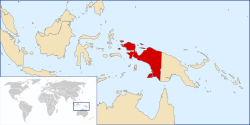 | |
| Country | Indonesia |
| Provinces | |
| Largest cities | |
| Area | |
| • Total | 412,214.61 km2 (159,156.95 sq mi) |
| Population (mid 2022 estimate)[1] | |
| • Total | 5,601,888 |
| • Density | 14/km2 (35/sq mi) |
| Time zone | UTC+09:00 (Indonesia Eastern Time) |
| ISO 3166-2 | ID-PP[2] |
| Vehicle registration plates |
|
Western New Guinea, also known as Papua, Indonesian New Guinea, and Indonesian Papua,[3] is the western half of the island of New Guinea granted to Indonesia in 1962. Given the island is alternatively named Papua, the region is also called West Papua (Indonesian: Papua Barat).[4]
Lying to the west of Papua New Guinea and geographically a part of the Australian continent, the territory is almost entirely in the Southern Hemisphere and includes the Biak and Raja Ampat archipelagoes. The region is predominantly covered with rainforest where traditional peoples live, including the Dani of the Baliem Valley. A large proportion of the population live in or near coastal areas. The largest city is Jayapura.
In the late 1940s, territories of the
In 2020, West Papua and Papua provinces had a census population of 5,437,775, the majority of whom are indigenous;[6] the official estimate as of mid-2022 was 5,601,888.[1]
The official language is
Name
Speakers align themselves with a political orientation when choosing a name for the western half of the island of New Guinea.[8] The official name of the region is "Papua" according to the International Organization for Standardization (ISO).[2][9] Independence activists refer to the region as "West Papua", while Indonesian officials have also used "West Papua" to name the western province of the region since 2007.[10] Historically, the region has had the official names of Netherlands New Guinea (1895–1962), West New Guinea or West Irian (1962–1973), Irian Jaya (1973–2002), and Papua (2002–present).[11] The expected Indonesian translation of "Western New Guinea", Nugini Barat, is currently only used in historical contexts such as kampanye Nugini Barat "Western New Guinea campaign".
Geography

The region is 1,200 kilometres (750 miles) from east to west and 736 kilometres (457 miles) from north to south. It has an area of 412,214.61 square kilometres (159,157 square miles), which equates to approximately 22% of Indonesia's land area. The border with Papua New Guinea mostly follows the 141st meridian east, with one section defined by the Fly River.[12]
The island of New Guinea was once part of the Australian landmass and lay on the continent of
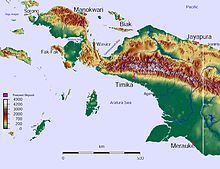
The region has 40 major rivers, 12 lakes, and 40 islands.[
The dry season across the region is generally between May and October; although drier in these months, rain persists throughout the year.[citation needed] Strong winds and rain are experienced along the north coast from November to March. However, the south coast experiences an increase in wind and rain between April and October, which is the dry season in the Merauke area, the only part of Western New Guinea to experience distinct seasons.[citation needed] Coastal areas are generally hot and humid, whereas the highland areas tend to be cooler.[citation needed]
Ecology
Lying in the Asia-Australian transition zone near Wallacea, the region's flora and fauna include Asiatic, Australian, and endemic species.[citation needed] The region is 75% forest and has a high degree of biodiversity. The island has an estimated 16,000 species of plants, 124 genera of which are endemic.[citation needed] The mountainous areas and the north are covered with dense rainforest. Highland vegetation also includes alpine grasslands, heath, pine forests, bush and scrub. The vegetation of the south coast includes mangroves and sago palms and in the drier southeastern section, eucalypts, paperbarks, and acacias.
Marsupial species dominate the region; there are an estimated 70
In February 2005, a team of scientists exploring the Foja Mountains discovered numerous new species of birds, butterflies, amphibians, and plants, including a species of rhododendron that may have the largest bloom of the genus.[16]
Environmental issues include deforestation, the spread of the introduced crab-eating macaque, which now threatens the existence of native species, and discarded copper and gold tailings from the Grasberg mine.[17]
Flora and fauna on the Bird's Head Peninsula

The
Road construction, illegal logging, commercial agricultural expansion, and ranching potentially threaten the integrity of the ecoregion.[19] The southeastern coast of the Bird's Head Peninsula forms part of the Teluk Cenderawasih National Park.[20]
Administration

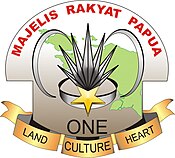

Western New Guinea is currently administered as six Indonesian provinces:
| Province | Customary Territory |
Area in km2 |
Capital | Regency (kabupaten) |
City (kota) |
|---|---|---|---|---|---|
| Central Papua | Mee Pago and parts of Saireri[a][21] | 61,072.92 | Wanggar, Nabire | Deiyai Dogiyai Intan Jaya Mimika Nabire Paniai Puncak Puncak Jaya |
– |
| Highland Papua | La Pago[b][22] | 51,213.34 | Walesi and Wouma, Jayawijaya | – | |
| Papua | Tabi (Mamta)[c] and rest of Saireri[23] | 82,680.95 | Jayapura | Biak Numfor Jayapura Keerom Mamberamo Raya Sarmi Supiori Waropen Yapen Islands |
Jayapura |
| South Papua | Anim Ha[24] | 117,849.16 | Salor, Merauke | Asmat Boven Digoel Mappi Merauke |
– |
| Southwest Papua | Half of Doberai[25] | 39,122.93 | Sorong | Maybrat Raja Ampat Sorong South Sorong Tambrauw |
Sorong |
| West Papua | Rest of Doberai and Bomberai[26] | 60,275.33 | Manokwari | Teluk Wondama
|
– |
History
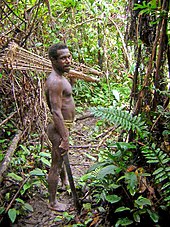
Pre-colonial history
Papuan habitation of the region is estimated to have begun between 42,000 and 48,000 years ago.[27] Research indicates that the highlands were an early and independent center of agriculture, and show that agriculture developed gradually over several thousands of years; the banana has been cultivated in this region for at least 7,000 years.[28]
Austronesian peoples migrating through Maritime Southeast Asia settled in the area at least 3,000 years ago, and populated especially in Cenderawasih Bay. Diverse cultures and languages have developed in situ; there are over 300 languages and two hundred additional dialects in the region (see Papuan languages, Austronesian languages, Central–Eastern Malayo-Polynesian languages).
The 14th-century
European conquest
In 1526–27, the
In 1545 the Spaniard
Near the end of the sixteenth century, the
Dutch rule

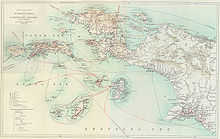
In 1660, the Dutch recognised the Sultan of Tidore's sovereignty over New Guinea. New Guinea thus became notionally Dutch as the Dutch held power over Tidore. In 1793, Britain established a settlement near Manokwari. However, it failed. By 1824 Britain and the Netherlands agreed that the western half of the island would become part of the Dutch East Indies. In 1828 the Dutch established the settlement of Fort Du Bus at Lobo (near Kaimana), which also failed. Great Britain and Germany had recognised the Dutch claims on western New Guinea in treaties of 1885 and 1895. Dutch activity in the region remained minimal in the first half of the twentieth century. Dutch, US, and Japanese mining companies explored the area's rich oil reserves in the 1930s. In 1942, the northern coast of West New Guinea and the nearby islands were occupied by Japan.[36] In 1944, Allied forces gained control of the region through a four-phase campaign from neighbouring Papua New Guinea. The United States constructed a headquarters for MacArthur at Hollandia (Jayapura), intended as a staging point for operations to retake the Philippines. Papuan men and resources were used to support the Allied war effort in the Pacific. After the war's end, the Dutch regained possession of the region.
Since the early twentieth century, Indonesian nationalists had sought an independent Indonesia based on all Dutch colonial possessions in the Indies, including western New Guinea. Some even founded local-based political parties, such as Indonesian Irian Independence Party (PKII) in 1946. In December 1949, the Netherlands recognised Indonesian sovereignty over the Dutch East Indies with the exception of Dutch New Guinea, the issue of which was to be discussed within a year. The Dutch successfully argued that Western New Guinea was "geographically very different" from Indonesia and the people were also very ethnically different. In an attempt to prevent Indonesia taking control of the region and to prepare the region for independence, the Dutch significantly raised development spending from its low base,[37] began investing in Papuan education, and encouraged Papuan nationalism. A small western elite developed with a growing political awareness attuned to the idea of Papuan independence, with close links to neighbouring eastern New Guinea, which was administered by Australia.[38] A national parliament was elected in 1961 and the Morning Star flag raised on 1 December, with independence planned in exactly 9 years' time.
Annexation and integration into Indonesia

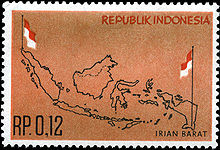
Under the terms of the
The Free Papua Movement (OPM) has engaged in a pro-independence conflict with the Indonesian military since the 1960s. This has been in response to the initial take over of the region and multiple killings and other human rights violations by Indonesian troops, causing many West Papuans and international organisations to describe the situation in West Papua as "genocide".[45] Rebellions occurred in remote mountainous areas in 1969, 1977, and the mid-1980s, occasionally spilling over into Papua New Guinea.

In 1980, the Trans Irian Jaya Highway, currently Trans-Papua Highway, began construction. The highway would link unconnected cities and regions across the region, which were previously only accessible by sea or, for inland areas, by air. However, some experts suggested prioritizing development of local indigenous people over infrastructure development[46] in order to be parallel with non-Papuan migrants, who were progressively inhabiting Western New Guinea's cities at the time.
In the
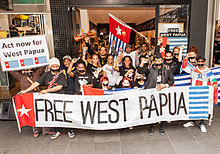
In 2011, Indonesia submitted an application for membership to the Melanesian Spearhead Group (MSG) for the two Papua provinces (as well as 3 other melanesian dominated provinces) and was granted observer status.[47] The West Papua National Council for Liberation independence movement made an unsuccessful application for membership to the MSG in 2013 after which the United Liberation Movement for West Papua (ULMWP) was established in December 2014 to unite the three main political independence movements under a single umbrella organisation. In June 2015, the ULMWP was granted MSG observer status as representative of West Papuans outside the country while Indonesia was upgraded to associate member.[48][49]
In 2016, at the
The
In July 2022 three additional provinces were created from parts of the existing Papua Province. The new provinces were Central Papua, Highland Papua and South Papua. In November 2022, Southwest Papua was created from the western part of West Papua Province. Thus, including the residual West Papua Province and Papua Province, there were then six provinces covering Western New Guinea.
Demographics
| Year | Pop. | ±% |
|---|---|---|
| 1971 | 923,440 | — |
| 1980 | 1,173,875 | +27.1% |
| 1990 | 1,648,708 | +40.5% |
| 1995 | 1,942,627 | +17.8% |
| 2000 | 2,220,934 | +14.3% |
| 2010 | 3,593,803 | +61.8% |
| 2020 | 5,437,775 | +51.3% |
| 2021 | 5,512,275 | +1.4% |
| 2022 | 5,601,888 | +1.6% |
The population of the region was estimated to be 5,601,888 in mid 2022.
The region is home to around 312 different tribes, including some
As in Papua New Guinea and some surrounding east Indonesian provinces, a large majority of the population is Christian. In the 2010 census, 65.48% identified themselves as Protestant, 17.67% as Catholic, 15.89% as Muslim, and less than 1% as either Hindu or Buddhist.[58][59] There is also a substantial practice of animism among the major religions, but this is not recorded by the census.[citation needed]
Haplogroups
There are 6 main
- Haplogroup M is the most frequently occurring Y-chromosome haplogroup in Western New Guinea.[60]
- In a 2005 study of Papua New Guinea's ASPM gene variants, Mekel-Bobrov et al. found that the Papuan people have among the highest rate of the newly evolved ASPM haplogroup D, at 59.4% occurrence of the approximately 6,000-year-old allele.[61]
- .
- Haplogroup S occurs in eastern Indonesia (10–20%) and Island Melanesia (~10%), but reaches greatest frequency in the highlands of Papua New Guinea (52%).[62]
Culture
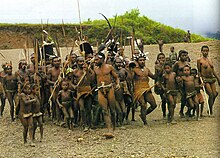
Papuans have significant cultural affinities with the inhabitants of Papua New Guinea.[citation needed] As in Papua New Guinea, the peoples of the highlands have traditions and languages distinct from the peoples of the coast, though Papuan scholars and activists have recently detailed cultural links between coast and highlands as evidenced by close similarity of family names.[citation needed] In some parts of the highlands, the koteka (penis gourd) is worn by males in ceremonies. The use of the koteka as everyday dress by Dani males in Western New Guinea is still common.
A culture of
Foreign journalism
The Indonesian government is very strict in giving foreign journalists permission to enter Western New Guinea, considering that this region is very vulnerable to separatist movements. As formerly in East Timor, Indonesia's former territory, the Indonesian administration takes great efforts to filter the information that gets out of Western New Guinea.[64] However, there is no prohibition for journalists to go to the region. In 2012, the Ministry of Foreign Affairs received 11 applications for permission to cover Papua from a number of foreign media. Of 11 requests, five were approved while the other six were rejected. Meanwhile, in 2013, requests for permission to cover Papua by foreign media soared to 28. At that time, the ministry approved 21 letters of application and rejected the other seven.[65]
The process of admitting foreign press and NGOs, which was previously complicated, began to be facilitated in 2015. Kompas.com explained that Jokowi officially revoked the ban on foreign journalists from entering Papua. According to him, Papua is the same as other regions of Indonesia. However, as of today foreign journalists are still required to apply for permission to enter Papua through the Ministry of Foreign Affairs.[66]
See also
- Free Papua Movement
- Kurima Valley
- List of rivers of Western New Guinea
- Papua conflict
- Terianus Satto
Notes
- ^ Mostly in the region Mee Pago but Nabire Regency is a part of Saireri.
- ^ shortened from Lano Pago
- ^ shortened from Mamberamo-Tabi
References
- ^ a b c d Badan Pusat Statistik, Jakarta, 2023.
- ^ a b "Indonesia Provinces". www.statoids.com.
- ^ "Indonesian Papua: A Local Perspective on the Conflict". International Crisis Group. 2007. Retrieved 23 April 2021.
- ^ Saltford, J. (2003). The United Nations and the Indonesian Takeover of West Papua, 1962–1969: the anatomy of betrayal (1st ed.). London: Routledge.
- ^ "Papua". Encyclopædia Britannica. Retrieved 3 November 2020.
- ^ "BPS Provinsi Papua Barat".
- JSTOR 41057027.
- University of Hawaii Press. p. xxv.
- ^ Kayo, Edison Sutan (6 April 2015). "Kode singkatan geografis wilayah di Indonesia". Kode Singkatan (in Indonesian).
- ^ "West Irian Jaya officially renamed West Papua angering independence movement". Radio New Zealand. 26 April 2007.
- UNSW Press. p. 150.
- ^ Frank Jacobs (13 March 2012). "Who Bit My Border?". The New York Times. Archived from the original on 17 March 2012.
- ^ Whitten (1992), p. 182
- ^ List at GunungBagging.com Archived 31 January 2012 at the Wayback Machine Retrieved 26 January 2012.
- JSTOR 2258776.
- ^ Robin McDowell: 'Lost world' yields exotic new species Archived 28 March 2006 at the Wayback Machine – The Vancouver Sun – 8 February 2006
- ^ "Grasberg – IntelligenceMine". Archived from the original on 20 June 2014. Retrieved 15 July 2017.
- ^ Flip van Helden: A bird's eye view of the Bird's Head Peninsula, in Irian Jaya Studies Programme for Interdisciplinary Research (IIAS) Newsletter nr.37, June 2005 Archived 11 June 2011 at the Wayback Machine, retrieved 11 May 2010
- ^ a b WWF: Bird wonders of New Guinea's western-most province Archived 16 July 2011 at the Wayback Machine, retrieved 11 May 2010
- ^ Ministry of Forestry: Teluk Cenderawasih NP Archived 29 December 2010 at the Wayback Machine, retrieved 11 May 2010
- ^ "Profil Provinsi Papua Tengah Halaman all". 2 July 2022.
- ^ "Profil Provinsi Papua Pegunungan Halaman all". 2 July 2022.
- ^ "Wilayah Adat Tabi Saireri Sepakati 11 Poin Evaluasi Otsus". 29 August 2020.
- ^ "Profil Merauke, Ibu Kota Provinsi Papua Selatan Halaman all". 3 July 2022.
- ^ "Indonesia Kini Miliki 38 Provinsi, Ini Profil Provinsi Papua Barat Daya". 18 November 2022.
- ^ "Dukungan Lembaga Kultural Orang Asli Papua Barat untuk Paulus Waterpauw - Kabar Papua". 12 May 2022.
- . Archived 19 August 2014
- ^ "Onin Peninsula". Geographic Names. Archived from the original on 4 March 2016.
- ISBN 978-1-925022-43-8.
- ISSN 2580-9237. Retrieved 24 April 2021.
- ISBN 978-0-911818-71-0.)
{{cite book}}: CS1 maint: others (link - ^ GELPKE, J.H.F. SOLLEWUN (December 1992). "On the Origin of the Name Papua" (PDF). Archived from the original (PDF) on 4 March 2016. Retrieved 7 January 2016.
- ISBN 0-85558-956-6
- ISBN 978-1-74059-154-6.
- ^ L, Klemen. "The Fall of Dutch New Guinea, April 1942". Forgotten Campaign: The Dutch East Indies Campaign 1941–1942. Archived from the original on 23 February 2012.
- ^ McDonald (1980), p. 65
- ^ McDonald (1980), p. 64.
- ^ Vickers (2005), p. 139
- ^ McDonald, Hamish (28 January 2008). "No End to Ambition". Sydney Morning Herald. Archived from the original on 3 November 2012.
- ^ "Western New Guinea" (PDF). west-papua.nl. Archived (PDF) from the original on 4 March 2016. Retrieved 29 July 2015.
- ISBN 978-0-00-635721-6.
- ^ Friend (2003), p. 72 (expand reference)
- ^ Singh, Bilveer Papua: Geopolitics and the Quest for Nationhood, Transaction Publishing, 2008 p. 86
- ISBN 978-962-8314-621. Archived(PDF) from the original on 27 April 2015. Retrieved 29 July 2015.
- ^ Firdausi, Fadrik Aziz (2018). "Trans Irian Jaya, Proyek Orde Baru Untuk Menyambungkan Papua". Tirto.id. Retrieved 15 October 2020.
- ^ Sally Andrews (3 April 2015). "West Papua: Melanesian Spearhead Group has a tough decision to make". Lowly Interpreter. Archived from the original on 5 October 2016. Retrieved 3 October 2017.
- ^ Armbruster, Stefan (26 June 2015). "Melanesia takes lead on future West Papuan peace". SBS News. Archived from the original on 2 October 2017. Retrieved 2 October 2017.
- ^ Fox, Liam (25 June 2015). "Indonesia admitted to Melanesian Spearhead Group, West Papuan group given observer status". ABC News Pacific Beat. Archived from the original on 14 January 2017. Retrieved 2 October 2017.
- ^ "Pacific leaders raise West Papua at the UN". Radio New Zealand. 26 September 2016. Archived from the original on 5 October 2017. Retrieved 4 October 2017.
- ^ a b "Indonesia accuses Pacific nations of 'misusing' the United Nations assembly after Papua criticisms". ABC News Pacific Beat. Australian Broadcasting Corporation. 26 September 2016. Archived from the original on 14 October 2017. Retrieved 4 October 2017.
- ^ "Fiery debate over West Papua at UN General Assembly". Radio New Zealand. 27 September 2017. Archived from the original on 1 October 2017. Retrieved 1 October 2017.
- ^ "Indonesian police ban violent protests, separatism in Papua". Reuters. 2 September 2019.
- ^ "Jumlah Penduduk Menurut Agama" (in Indonesian). Ministry of Religious Affairs. 31 August 2022. Retrieved 29 October 2023.
Muslim 241 Million (87), Christianity 29.1 Million (10.5), Hindu 4.69 million (1.7), Buddhist 2.02 million (0.7), Folk, Confucianism, and others 192.311 (0.1), Total 277.749.673 Million
- ^ "Indonesia's transmigration program threatens Papuans". Ucanews. 5 November 2014.
- ^ International, Survival. "Papuan Tribes". www.survival-international.org. Archived from the original on 29 July 2009. Retrieved 15 July 2017.
- ^ "Local Papua languages disappear | Stichting Papua Cultureel Erfgoed (PACE)". www.papuaerfgoed.org. Archived from the original on 18 March 2021. Retrieved 9 September 2019.
- ISBN 978-979-064-417-5.
- Badan Pusat Statistik. 2010.
- ^ Kayser M, Brauer S, Weiss G, Schiefenho¨vel W, Underhill P, Shen P, Oefner P, Tommaseo-Ponzetta M, Stoneking (2003) Reduced Y-Chromosome, but Not Mitochondrial DNA, Diversity in Human Populations from West New Guinea Am J Hum Genet 72:281–302
- ^ "Ongoing Adaptive Evolution of ASPM, a Brain Size Determinant in Homo sapiens" Archived 24 June 2008 at the Wayback Machine, Science, 9 September 2005: Vol. 309. no. 5741, pp. 1720–1722.
- ^ Murray P. Cox and Marta Mirazón Lahr, "Y-Chromosome Diversity Is Inversely Associated With Language Affiliation in Paired Austronesian- and Papuan-Speaking Communities from Solomon Islands," American Journal of Human Biology 18:35–50 (2006)
- ^ "Papua New Guinea massacre of women and children highlights poor policing, gun influx". ABC News. 11 July 2019.
- S2CID 159306665.
- ^ wepi (28 October 2018). "Irian Jaya". West Papua Indonesia. Retrieved 9 September 2019.
- ^ https://www.kemlu.go.id/newdelhi/en/layanan-konsuler/prosedur-dan-oeraturan/Pages/Pelayanan-Media.aspx [dead link]
- Conboy, Ken. 2003. Kopassus. Equinox Publishing, Jakarta Indonesia. ISBN 979-95898-8-6
- L, Klemen (2000). "Forgotten Campaign: The Dutch East Indies Campaign 1941–1942".
- Leith, Denise. 2002. The Politics of Power: Freeport in Suharto's Indonesia. Honolulu: University of Hawaii Press. ISBN 0-8248-2566-7
- ISBN 1903998271
- Penders, C.L.M., The West New Guinea débâcle. Dutch decolonisation and Indonesia 1945–1962, Leiden 2002, KITLV
- "Arrow Against the Wind." Narrative of documentary on people of Asmat and Dani, their culture, and their relationship with the nature [1] Archived 28 August 2008 at the Wayback Machine
- Throwim Way Leg by Tim Flannery
- Neles Tebay : West Papua. The struggle for peace with justice. Catholic Institute for International Relations: London 2005, ISBN 1 85287 316 7.
- Marshall, A.J. and B. Beehler (eds.), "The Ecology of Papua". 2007. Parts 1 & 2 as Vol. 6 in "The Ecology of Indonesia" series. Singapore: Periplus Press.


